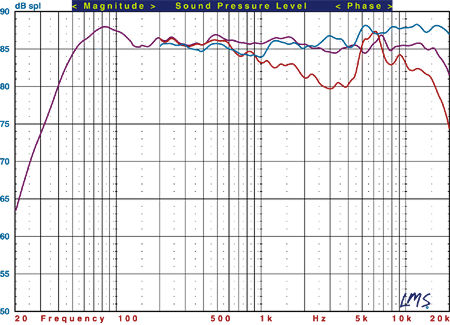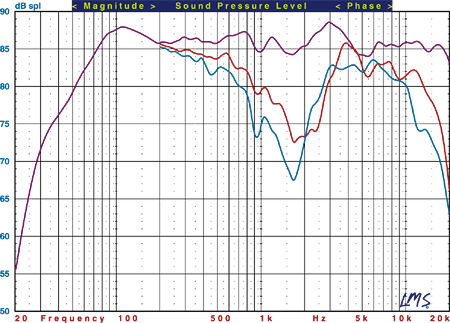Dynaudio Contour S5.4, SC, S1.4 surround speaker system Measurements
All measurements shown were taken with the speakers' grilles removed. The Dynaudio Contour S5.4's ported enclosure is tuned to approximately 30Hz, and the minimum value of its impedance measured 3.9ohms at 100Hz. I would rate its nominal impedance at 5ohms; the S5.4 should be a relatively easy load for any amplifier comfortable with a 4ohms load. Its sensitivity measured 86dB/W/m across most of the frequency range.
The S5.4's front response is shown in Fig.1 (violet). This is the 1-meter pseudo-anechoic response averaged across a 30° forward angle (+/-15°) in the horizontal, combined with the nearfield responses of the woofers and port. Because of the relatively low tweeter position, we took the on-axis measurements at a height of 37 inches. This was above the tweeter, but a reasonable estimate for the height of a listener's ears. This elevation proved to be well-chosen; the S5.4's averaged measured response is exceptionally smooth and flat, and one of the best we have seen. The speaker's output fell within a +/-1.5dB window from approximately 130Hz to 16kHz, with no significant peaks within this range. The wide off-axis response tracks the on-axis averaged response closely, apart from a gentle rolloff at the highest frequencies. The speaker's effective lower limit (–10dB) was 33Hz relative to the output at 200Hz.

Fig. 1
The vertical responses in Fig.2 are respectable, though we would advise against listening very much higher than the 37-inch ear height chosen for our on-axis measurements. If you have to sit higher, a slight tilt-back of the cabinet might give a better overall balance.

Fig. 2
The Contour SC center speaker's ported cabinet is tuned to approximately 40Hz. Its impedance magnitude dips to a minimum of 3ohms at 193Hz, and its nominal impedance appears to be about 4.5ohms; like the S5.4, the SC should be easily driven by any competent amplifier. Also like the S5.4, the SC's sensitivity measured approximately 86dB/W/m.
The SC's horizontal front response, derived and averaged as described for the S5.4 (except here taken at tweeter height), is shown in Fig.3 (violet). The speaker's effective lower limit (–10dB) is 40Hz relative to its output at 200Hz. Overall, the response was approximately +/-2.5dB from 68Hz to 19kHz, and would have been smoother but for a rather prominent peak at 3kHz—right in the region of the ear's maximum sensitivity. While this could artificially enhance speech intelligibility, it might also add a slight edge to the sound. FM did not find either of these problems in his listening tests.

Fig. 3
Nor was FM bothered by any off-axis aberrations. Fig.3 shows a dramatic suckout in the SC's response at just under 2kHz, as measured at angles far off-axis. But even at 30° off-axis (not shown), the dip below 2kHz is quite evident in our measurements (about –4.5dB at 1.8kHz). The vertical responses of Fig.4, however, indicate that the frequency response does not change significantly at reasonable locations above and below the tweeter axis.

Fig. 4
These results are a little mixed. The S5.4 is clearly a superbly engineered speaker all around—in terms of measurements, it's as good as any speaker we've reviewed. The SC is something less, and typical of 2-way, horizontally configured center-channel speakers in exhibiting a serious suckout as the listener moves off-axis in the region near the SC's crossover frequency. This did not cause FM problems in his listening tests, but could make the SC—like all such speakers—problematical for a group of several listeners.
Though we haven't tried any of them, there are alternatives to the SC for the center-channel. One would be the use of an additional Contour SR as a center-channel, if the physical configuration of your system will allow it. Better still might be a Dynaudio Confidence C1, a small bookshelf model that uses the same tweeter as the S5.4 (which neither the Contour SR nor the SC does). Best of all would be a third S5.4 for a center-channel, though that option (unless intended for multichannel audio only) would require a front-projection setup with a perforated screen.—Thomas J. Norton
- Log in or register to post comments




































































